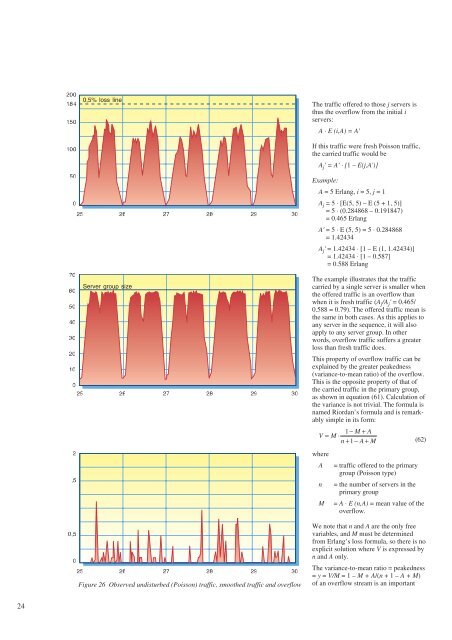Contents Telektronikk - Telenor
Contents Telektronikk - Telenor
Contents Telektronikk - Telenor
Create successful ePaper yourself
Turn your PDF publications into a flip-book with our unique Google optimized e-Paper software.
24<br />
200<br />
184<br />
150<br />
100<br />
50<br />
0<br />
25 26 27 28 29 30<br />
70<br />
60<br />
50<br />
40<br />
30<br />
20<br />
10<br />
0<br />
25 26 27 28 29 30<br />
2<br />
1,5<br />
1<br />
0,5<br />
0,5% loss line<br />
Server group size<br />
0<br />
25 26 27 28 29 30<br />
Figure 26 Observed undisturbed (Poisson) traffic, smoothed traffic and overflow<br />
The traffic offered to those j servers is<br />
thus the overflow from the initial i<br />
servers:<br />
A ⋅ E (i,A) = A'<br />
If this traffic were fresh Poisson traffic,<br />
the carried traffic would be<br />
Aj' = A' ⋅ [1 – E(j,A')]<br />
Example:<br />
A = 5 Erlang, i = 5, j = 1<br />
Aj = 5 ⋅ [E(5, 5) – E (5 + 1, 5)]<br />
= 5 ⋅ (0.284868 – 0.191847)<br />
= 0.465 Erlang<br />
A' = 5 ⋅ E (5, 5) = 5 ⋅ 0.284868<br />
= 1.42434<br />
Aj' = 1.42434 ⋅ [1 – E (1, 1.42434)]<br />
= 1.42434 ⋅ [1 – 0.587]<br />
= 0.588 Erlang<br />
The example illustrates that the traffic<br />
carried by a single server is smaller when<br />
the offered traffic is an overflow than<br />
when it is fresh traffic (Aj /Aj' = 0.465/<br />
0.588 = 0.79). The offered traffic mean is<br />
the same in both cases. As this applies to<br />
any server in the sequence, it will also<br />
apply to any server group. In other<br />
words, overflow traffic suffers a greater<br />
loss than fresh traffic does.<br />
This property of overflow traffic can be<br />
explained by the greater peakedness<br />
(variance-to-mean ratio) of the overflow.<br />
This is the opposite property of that of<br />
the carried traffic in the primary group,<br />
as shown in equation (61). Calculation of<br />
the variance is not trivial. The formula is<br />
named Riordan’s formula and is remarkably<br />
simple in its form:<br />
1− M + A<br />
V = M ⋅<br />
n +1− A + M<br />
(62)<br />
where<br />
A = traffic offered to the primary<br />
group (Poisson type)<br />
n = the number of servers in the<br />
primary group<br />
M = A ⋅ E (n,A) = mean value of the<br />
overflow.<br />
We note that n and A are the only free<br />
variables, and M must be determined<br />
from Erlang’s loss formula, so there is no<br />
explicit solution where V is expressed by<br />
n and A only.<br />
The variance-to-mean ratio = peakedness<br />
= y = V/M = 1 – M + A/(n + 1 – A + M)<br />
of an overflow stream is an important

















